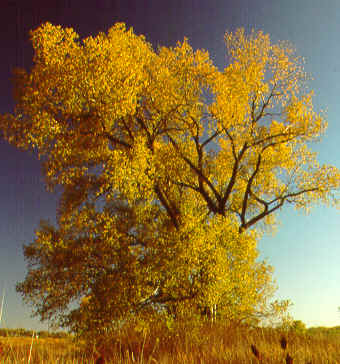 Cottonwoods can be either male or female. It is the fluffy white seeds produced by the females during early summer that give the tree its name. The seeds are very small, 1mm wide by 4 mm long, which is quite remarkable considering that they can become one of the largest trees in North America, up to 100 ft. high with massive trunks over 5 ft. in diameter. Photo Credit: Bob Gress
Cottonwoods can be either male or female. It is the fluffy white seeds produced by the females during early summer that give the tree its name. The seeds are very small, 1mm wide by 4 mm long, which is quite remarkable considering that they can become one of the largest trees in North America, up to 100 ft. high with massive trunks over 5 ft. in diameter. Photo Credit: Bob GressTrees Show Greater Promise As E85 Feedstock
It turns out that we do not need to consume or destroy food based crops or growing fields in order to reap the benefits of ethanol based bio-fuels.
Trees, specifically Cottonwood trees, can be raised and the leaves and twigs can be harvested and converted into Ethanol for use in E85 blended gasoline.
According to ECOworld via a study in 2005 by the U.S. Dept. of Energy and the U.S. Department of Agriculture, “United States has enough agricultural and forestry land to support production of over one billion tons of biomass, which could provide enough liquid bio-fuels to replace over a third of current transportation fuel consumption, and still continue to meet food, feed, and export demands.”
This from ECOworld -
Cellulosic Ethanol From Cottonwoods
We’ve always enjoyed growing cottonwood trees. They can grow about ten feet per year, and can eventually tower over 100 feet in height. If you want a quick forest, look no further.
As a feedstock for bioethanol, trees and crop forage display far greater potental via their cellulosic fibers than the yield from their food crops - sugar cane, cassava, corn - ever could.
As we point out in our post, “Ethanol From Cellulose,” the problem is that this process is much more technologically challenging. Simple extraction of oils and sugars from the food crops, as opposed to the forage, is much more viable today. But that may change.
In a report just released entitled “The First Tree Genome is Published,” the U.S. Dept. of Energy’s Joint Genome Institute claims “the analysis of the first complete DNA sequence of a tree, the black cottonwood or Populus trichocarpa, lays the groundwork that may lead to the development of trees as an ideal “feedstock” for a new generation of biofuels such as cellulosic ethanol.”
The report goes on to say they have ”identified 93 genes associated with the production of cellulose, hemicellulose and lignin, the building blocks of plant cell walls. The biopolymers cellulose and hemicellulose constitute the most abundant organic materials on earth, which by enzymatic action, can be broken down into sugars that in turn can be fermented into alcohol and distilled to yield fuel-quality ethanol and other liquid fuels.”
A lengthy study authored in 2005 by the U.S. Dept. of Energy and the U.S. Department of Agriculture found that the “United States has enough agricultural and forestry land to support production of over one billion tons of biomass, which could provide enough liquid biofuels to replace over a third of current transportation fuel consumption, and still continue to meet food, feed, and export demands.” Here is the full text of this report.
It could be a while before cellulosic refining is commercially viable, but in the meantime there are many economically viable examples of primary refining of sugars and oils from plant crops to produce bioethanol and biodiesel fuel. In the rapidly evolving market for alternative fuels and alternative automotive drivetrains, don’t write off biofuels, or the next generation of internal combustion engines.
Reference Here>>



No comments:
Post a Comment